Nukunu, Banggarla, Andyamathanha Country
Flinders Ranges Way winds up from Port Augusta on the coastal plain, through the foot hills of the Southern Ikara-Flinders Ranges to the historic township of Quorn. The visitor centre at Quorn is located within the picturesque railway station that houses the historic Pichi Richi Railway. Here helpful staff can assist with last minute campgound bookings for both the Ikara-Flinders Ranges and nearby council-run Warren Gorge.
Continued from South Australia Part 1 of 4 – Crossing The Nullarbor
The Ikara-Flinders Ranges contain an impressive array of large macropods of which the Yellow-footed Rock Wallaby is undoubtedly the most sought after. The itinerary for the week was built around the well known rock wallaby sites of Brachina Gorge, Warren Gorge and Arkaroola.
A final weather check before leaving internet range at Quorn predicted a moist lick being pulled from the Indian Ocean, that was going to make for an unusually damp Spring week in the Ikara-Flinders.
Flinders Ranges Way continues North from Quorn, across a flat arid plain fringed with jagged mountains for another 121kms to Wilpena Pound. The mountain sides are carpeted in native pine forests and purple Patersons Curse. North of the township of Hawker the imposing bluff of Wilpena Pound breaches the horizon like an enormous cetacean.
Emus are the most conspicuous of the Ikara-Flinders fauna and passing Wilpena Pound Drive a pair of Australia’s largest birds strutted stately alongside the highway.
Emu.

Brachina Gorge
Brachina Gorge Road provides the access to awesome Brachina Gorge. It runs from Flinders Ranges Drive in the East to the Outback Highway in the West, a total distance of around 20 kilometres. Teamsters Campground accessed from the Outback Highway and Brachina East Campground accessed from Flinders Ranges Drive can both be reached in 2WD in the absence of recent adverse weather events. (Check road conditions at Wilpena Pound Visitor Centre.)
The remaining section of road (around 4km) linking the campgrounds, bisects the Flinders Ranges and 4WD is advisable on account of a few shallow water crossings and rocky creek beds. That said, with good weather conditions a high clearance 2WD is adequate. Indeed on a previous visit to Brachina Gorge I had driven Brachina Gorge Road in a 2WD SUV hire car without incident.
Map showing Brachina Gorge.
Earlier that morning at Quorn I had booked a night ($24) at Brachina East Campground, situated 11.7km along Brachina Gorge Road. The campground is nestled on the bank of Aroona Creek amongst a grove of giant river gums with a lovely aspect. Once camp was set up I drove into the gorge to look for Yellow-footed Rock Wallabies.
Within walking distance of Brachina East Campground is the cliff face pictured below. Although it lacks scree slopes so typical of rock wallaby habitat, the ledges and caves of the cliff face warranted further exploration.
Rock Wallaby Habitat – Brachina Gorge.

Initially the cliff looked devoid of wallabies, but after closely scanning the crevices and ledges superbly camouflagued Yellow-footed Rock Wallabies began to materialise, including the female with pouch young seen below. It was mid-afternoon and so I was surprised to find upto five rock wallabies active at this time.
Yellow-footed Rock Wallaby.

Scattered populations of Yellow-footed Rock Wallaby can be found throughout Western parts of NSW and Queensland, but the stronghold of the species is South Australia where they are found throughout the Flinders, Olary and Gawler Ranges. The species however has been under considerable pressure since the European colonisation of Australia from a triple threat of habitat destruction, herbivore competition, and fox and cat predation.
The first nations Adnyamathanha people of the Northern Flinders know the Yellow-footed Rock Wallaby as Andu. As is so often the case, the indigenous name for native animals is better than the stuffy one given by Europeans, so for the remainder of the blog I have replaced the long-winded Yellow-footed Rock Wallaby with the indigenous name.
The spectacular pelage of Andu makes them Australia’s most attractive rock wallaby. The coat is an overall grey colour with dashes of white on the hip and cheek, while the ears, limbs and tail are a rich golden-orange. The impressive ringed tail is greater than the body length to provide the essential counterbalance needed when negotiating cliff faces.
Andu (Yellow-footed Rock Wallaby.)

I had visited Brachina Gorge previously in 2017 and remember it having little traffic. The experience this time was completely different due to the school holidays, with numerous 4WD’s on the gorge track.
There is an “official” rock wallaby viewing area about halfway along the gorge at the base of a South-facing scree slope. This signed area is fenced from the public and opposite a vehicle pullover bay. This too was busy and unfortunately the Andu were shy due to the volume of people.
As light began to fail I returned to the campground and shortly after dark was asleep. During the night I was vaguely aware of rain drumming on the tent, and from somewhere above in the foothills the soft hooting of a Boobook Owl.
The dawn chorus was in full swing as I roused from sleep the following morning. There was the melodic carolling of Magpies contrasting sharply with the cackle of Kookaburras and the incessant squawking of a Corella colony roosting high above in the red river gum hollows.
I packed camp early to continue North to Arkaroola but first spent quality time in Brachina Gorge. The gorge was delightfully devoid of people at this early hour and Andu were plentiful when revisiting sites from the previous day.
At 200kms the most direct route from Brachina to Arkaroola is via a series of back roads, over vast floodplains and past ancient mountain ranges. The corrugated road was in reasonable condition but regular hazards included dry creek crossings and washouts. The country was beautiful, nowhere more so than the Vulkathunha-Gammon Ranges on the final approach into Arkaroola.
Vulkathunha- Gammon Ranges.

After the long drive I was surprised to find the “Wilderness Lodge” teeming with tour buses and 4WD’s. The reception was clogged with guests checking out, so rather than waste time queing I set off to explore.
The first outbuilding I found had the “Yellow-footed Rock Wallaby Viewing Area.” attached on a verandah, and my heart immediately sank. Seventy white plastic chairs were arranged in neat rows around a manmade pile of rocks. It was clear habituated rock wallabies were enticed with food for guests. I knew at that moment I had made a mistake visiting Arkaroola.
When I was finally able to check-in, I booked on the extortionately priced 4WD ridgetop tour for the following evening. The accommodation was terrible, although I had at least been warned of this by a tour group at Brachina Gorge the previous day. The drab, tired room was furnished with an uncomfortable bed and a broken window lock indicated security clearly wasn’t a concern here.
It was tempting to cut my losses and return to the Flinders Range, which had it not been for the rough road and distance I would have done. Instead I put the wet tent from the previous night out to dry, and set off via a 1.5km steep return trail to climb Griseda Hill.
The final approach to the peak is along a ridge, and here a few Andu disappeared into clefts in the rocks while high above a Wedge-tailed Eagle soared the thermals. I sat down to take in the neverending views under a sky heavy with cloud, when the rain that had been threatening all day finally broke into a terrential downpour. As I retreated under an overhang, bolts of lightning struck surrounding peaks. The top of a mountain is no place to be during an electrical storm and so I high-tailed it back down the mountain at breakneck speed, arms flailing like windmills.
I arrived back at the room soaking but safe, and the wet tent I had put out to dry was once again sopping. A note had been pushed under my door to explain I had been bumped from the evening to morning 4WD ridgetop tour to make way for a family. Unbelievably a staff member had found a spare key for my room and left it in the door, fortunately my gear hadn’t been stolen. Fawlty Towers had nothing on this place……
I cancelled the tour booking, wrote off the day and went to bed. Guests were drinking on the shared verandah until the early hours. It was horrible. The following day before the sun breached the horizon, I packed the car and got the hell out of Arkaroola. It was such a relief to be leaving.
Brachina Gorge (Again)
I chose an alternate route to return to the Flinders Ranges via Leigh Creek, and found wildlife plentiful on the drive. There were mobs of Red Kangaroos leaving the Vulkathunga-Gammon Ranges, a Wedge-tailed Eagle demolishing roadkill on the approach to the town of Nepabunna, and a couple of fabulous Bearded Dragons basking roadside now the inclement weather that had dominated recent days had dispersed.
I approached Brachina Gorge from the West past Teamsters Campground and it was great to be back. Sunlight lit up the ochre shades of the gorge walls and the warm day had attracted a family of Emus to the creek to drink. I had no accommodation booked so stopped by Wilpena Visitor Centre and secured two nights at Teamsters Campground.
As the shadows lengthened and the gorge emptied of 4WD’s, I found myself alone with the Andu at the official rock wallaby viewing area. The animals were more relaxed at this later hour, grooming on boulders and ultimately venturing beyond the fence to forage. Close proximity viewing allowed appreciation of the more subtle characteristics of the Andu, such as the brown mid-dorsal stripe running from the head to mid-back.
Andu (Yellow-footed Rock Wallaby.)

I drove past Brachina Campground East into the hilly country beyond, and passed an Echidna snuffling along a creekline looking for supper. Wallaroos also known as Hill Kangaroos or Euros are common in this area and were reasonably confiding.
The easiest way to distinguish Wallaroos from Kangaroos is from habitat. Wallaroos are found in rocky/hilly country whereas Kangaroos prefer the open plains. Wallaroos are also smaller, stockier and have a shaggier coat. Wallaroos are mostly solitary compared to the gregarious Kangaroo, so two Wallaroos together are almost always a mother and last years young at foot.
Wallaroos.

There are only five campsites at Teamsters Campground and I was last one in right on dark. The smell of woodsmoke drifted through the air and I was delighted when an Andu hopped through camp as I ate dinner. A brilliant half-moon lit the gorge as a frog chorus echoed through the valley from nearby Brachina Creek. I spent time before bed stalking the creek for the owner of the frogcall without success.
The next day before sunrise while the other campers slept. I drove into the gorge on what was a cold, still start to the day and captured the magical moment the first of the suns rays struck the surrounding peaks.
Brachina Gorge at Dawn.

Birdsong was the only sound as I explored along the rocks, hills and cliffs of the gorge. There were Andu everywhere, and every cliff face seemed to contain a pretty striped face or two.
Andu (Yellow-footed Rock Wallaby.)

Today was forecast to be another sunny day, perfect to climb to the summit of Mount Ohlssen-Bagge, one of the many jagged peaks jutting skyward at the stunning natural amphitheatre of Wilpena Pound.
Mount Ohlssen Bagge
The trailhead for most walks at the Ikara-Flinders Ranges, including the 5.6km return Mount Ohlssen-Bagge, is the Wilpena Pound Visitor Centre. The first section of the trail is flat as it follows Wilpena Creek below a shady grove of mammoth red river gums. The trail then shears sharply left prior to the pound gap.
The track here becomes steeper and rocky underfoot as it ascends the outer slope of the pound wall, via a series of stairs interspersed with flat sections. This part of the trail is exposed with hardly any shade, and so an early start is advisable during the warmer months. I was hopeful the sunny conditions would bring out the reptiles, and indeed it wasn’t long before I stumbled on a Sleepy Lizard active in the vegetation adjacent to the trail.
Sleepy Lizard.
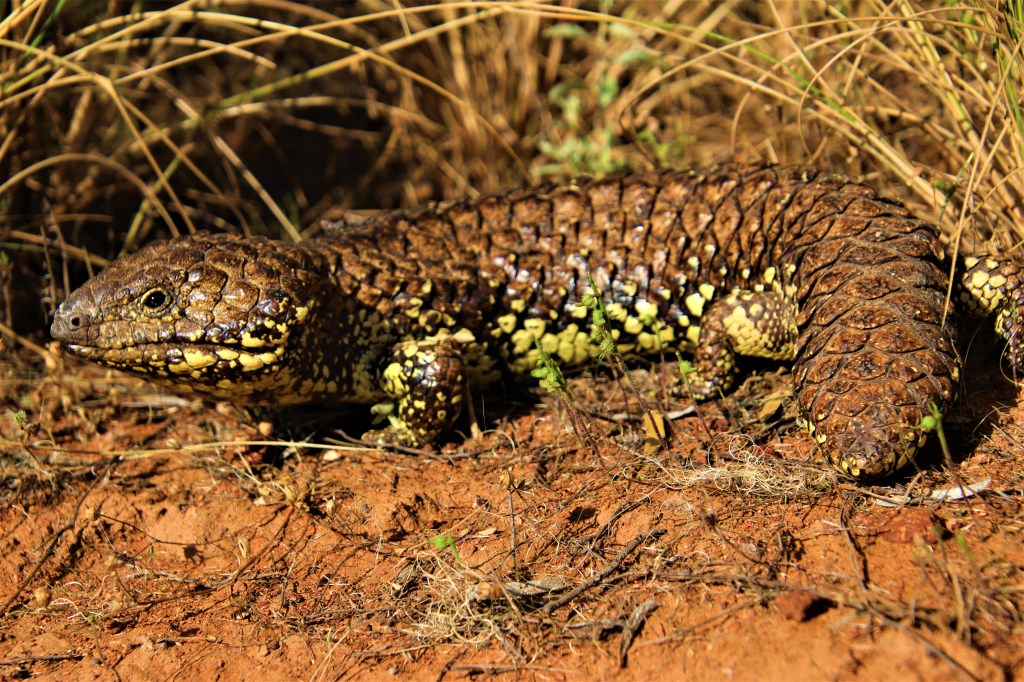
A common reptile of the Ohlssen-Bagge Trail is the Tawny Dragon. These delightfully coloured agamids with striking orange throats are easily seen basking on sun-heated rocks, often allowing close approach. Observing them provides a welcome break from the long, steep climb ever upwards.
Tawny Dragon.
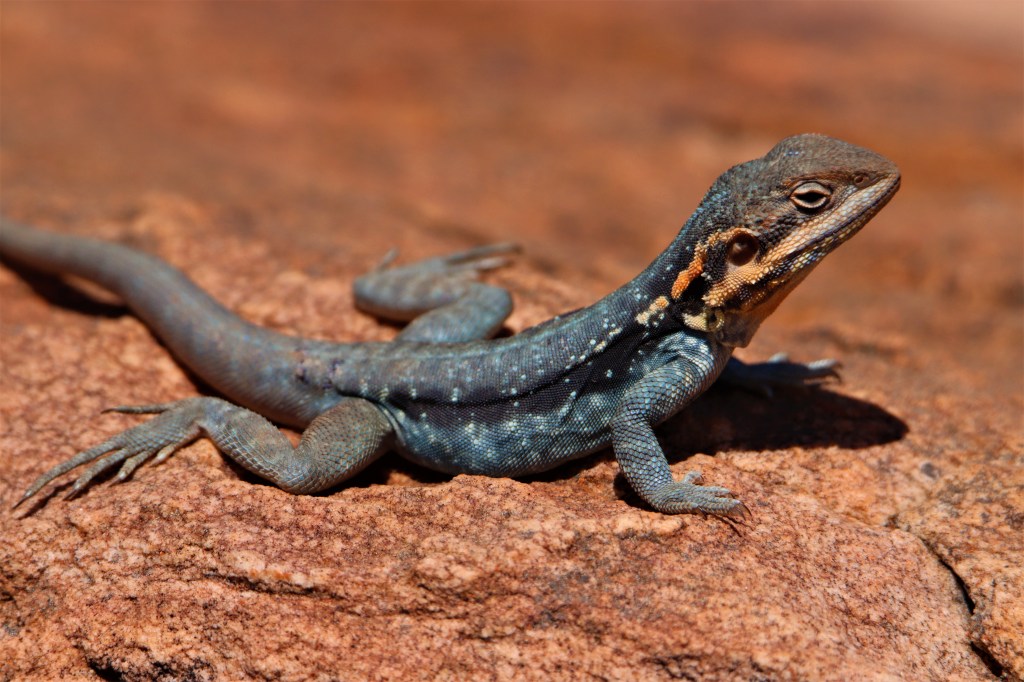
The peak of Mount Ohlssen-Bagge is at an elevation of 941m and provides superlative views both into and outside of the pound. To the North is St Mary’s Peak the highest peak in the Ikara-Flinders. West far beyond the opposite wall of the pound the jagged peaks of the Elder Range pierced the brilliant blue sky.
Views from the peak of Mount Ohlssen-Bagge.

As I sat on a series of rocky ledges to enjoy the commanding views, there was a flurry of activity in a nearby crevice as a family of Skinks took advantage of the warmth to soak up the suns rays. The Centralian Ranges Masked Rock Skink is named for the mask-like patterning around the eyes.
Centralian Ranges Masked Rock Skink.
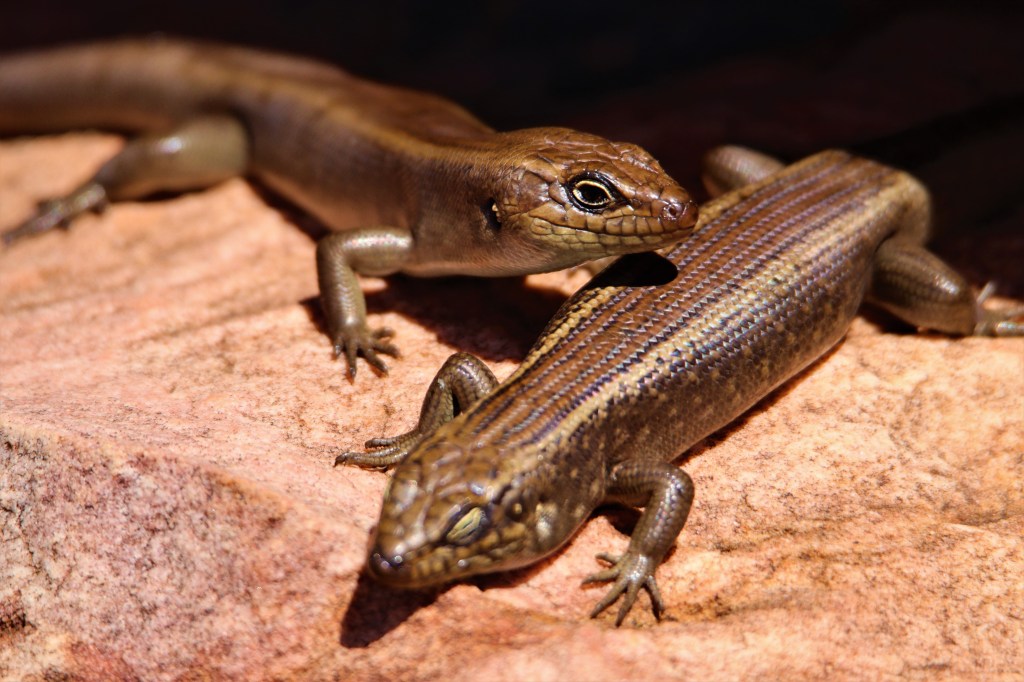
The terminus of the Mount Ohlssen-Bagge Trail is back at Wilpena Pound Visitor Centre, where fortunately a well-stocked store sells amongst many things ice-creams. As I enjoyed a refreshing treat an Emu was also seeking relief from the heat, vigourously bathing in a muddy puddle that had accumulated on the road.
Emu taking a Bath.
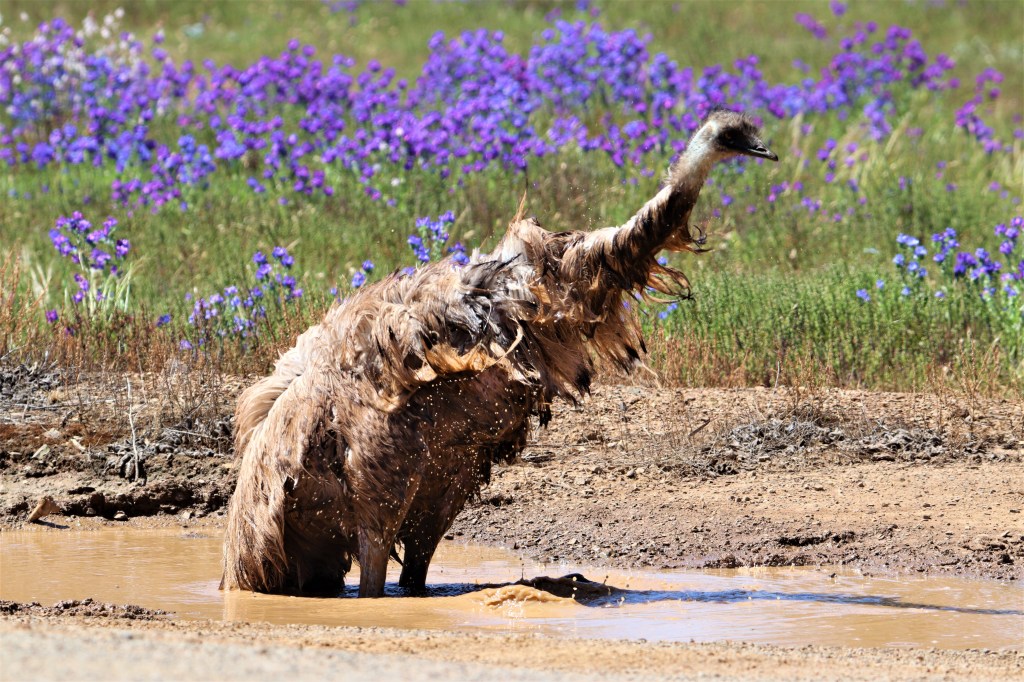
A lazy afternoon was enjoyed back at Teamsters Campground. As the day progressed cloud once again increased and the sunny spell was over. That evening I was the only human inhabitant at the campground. It was magical still evening in the gorge as darkness fell.
I was woken by a particularly heavy shower at 4am when the frog chorus in the nearby creek intensified to a crescendo. The calls could best be described as a series of fast croaks. I dressed and set out with the spotlight, determined to identify the owners of the calls.
The reason I had been unable to locate the frogs the previous night was because they were calling from beneath large stones in the creek, and the deafening calls were a result of amplification by these echo chambers. I photographed the species and later determined it as the Spotted Marsh Frog or Grass Frog (Lymnodynastes tasmaniensis.)
Spotted Marsh Frog (Lymnodynastes tasmaniensis.)

It was an unusual dawn chorus at Teamsters Campground where the call of frogs mix with birdsong. The bird calls included the Djiti-djiti of a Willie Wagtail, the soft chatter of a family of Fairy-Wrens and the harsh screech of Corellas travelling high above through the gorge.
I packed the tent and drove out of Brachina Gorge for the final time. Andu were as always plentiful at this early hour, although some were looking decidedly soggy after last night’s rain. The image below shows the large padded hind feet so perfectly adapted for a life amongst cliffs and boulders.
Andu (Yellow-footed Rock Wallaby.)
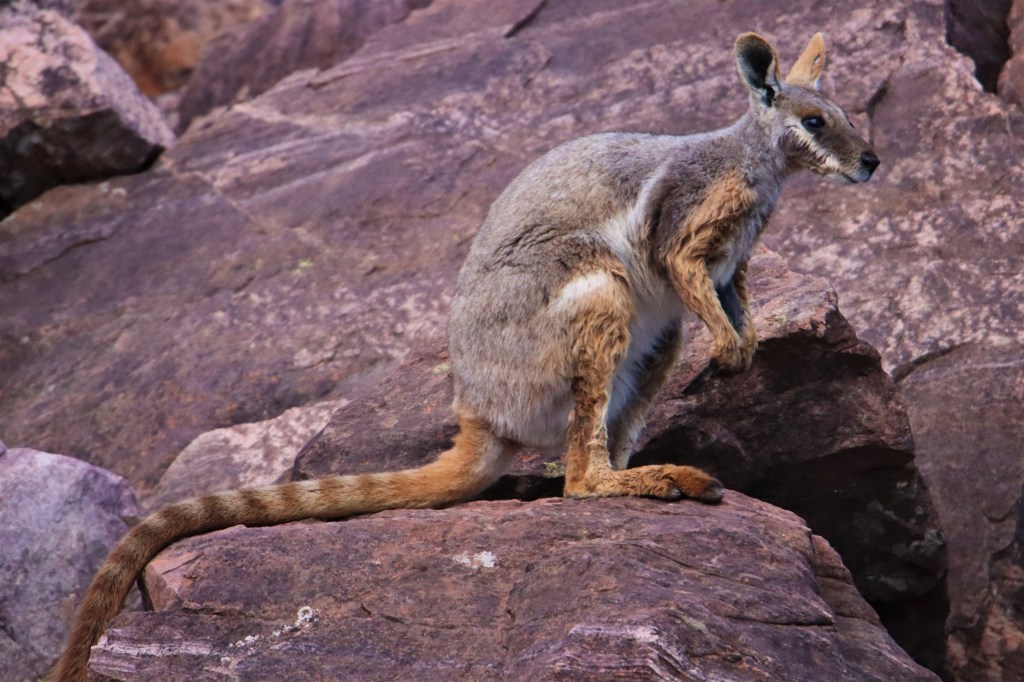
Instead of driving Brachina Gorge Road to Wilpena Campground I took the Bunyeroo Track which cuts through the gentle, pine-covered, rolling hills of Bunyeroo Valley, with great views of nearby Wilpena Pound peaks. Wallaroos were in good numbers along this track as it wound Southwards.
The bustling campground was almost at capacity due to the school holidays, contrasting sharply with the peace and quiet of Brachina Gorge. I took a late afternoon walk and met an Echidna. It had a face full of dirt from foraging in the soil for ants and termites that are the diet staple.
Echidna.

Further along a herd of feral goats were grazing a scree slope. Their destructive and clumsy hooves disturbing rocks and stones that tumbled down to the valley floor. The feral goat is the major competitor of Andu for food, water and shelter, and uncontrolled goat numbers had by the 1980’s resulted in much reduced and fragmented Andu populations.
Bounceback is a programme that seeks to control feral pests in the Ikara-Flinders and beyond which in 15 years removed an astounding 100,000 feral goats allowing Andu to well, bounceback! It was heartening to see Andu on the pound walk later that evening, they were on a scree slope only a kilometre from the campground.
In 2016 a successful reintroduction of Western Quoll (Idnya) into the Ikara-Flinders was undertaken after an absense of nearly 150 years. That night I spotlighted around the campground for this species. Although unsucessful, around ten Brushtail Possums (Virlda) were seen, another mammal successfully reintroduced to the Ikara-Flinders at the same time as the Quoll.
Virlda (Brushtail Possum.)

An early morning drive the following day resulted in an unusually close encounter with a Wedge-tailed Eagle. The magnificent Wedgie was perched on a solitary granite stone on a grassy hill, like a king surveying his kingdom.
Exiting the car, I slowly and nonchalantly climbed the hill, fully expecting the raptor to fly away. It wasn’t until I approached to within 20m that the bird began to show signs of discomfort, and so I sat quietly and enjoyed a magical experience in near proximity to Australia’s largest bird of prey, with the orange mountains as a backdrop.
Wedge-tailed Eagle.
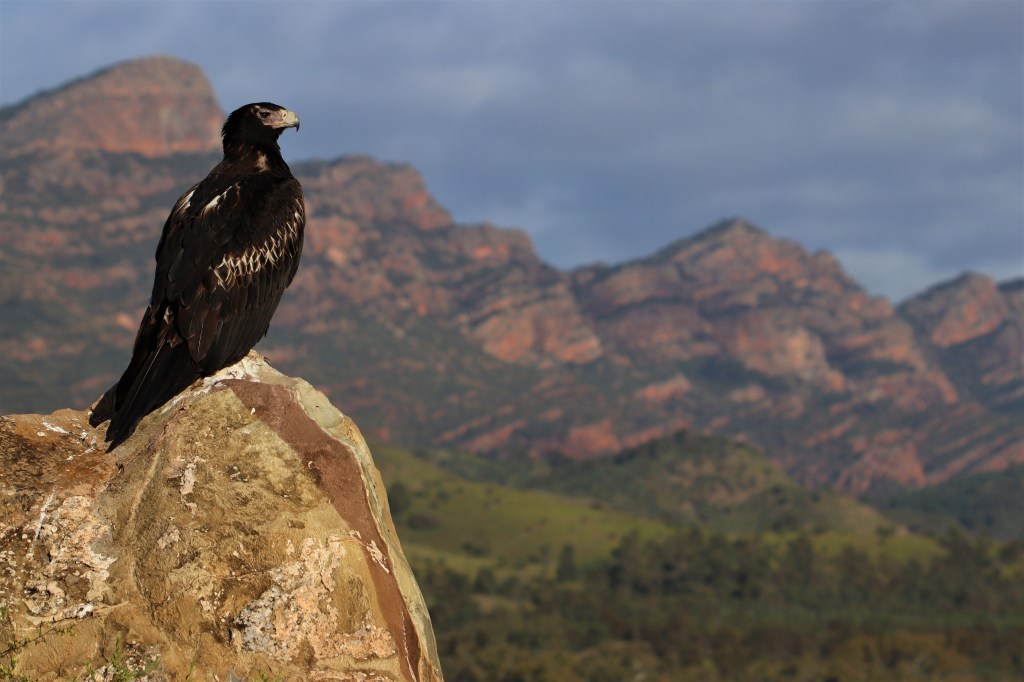
The Wedge-tailed Eagle is found in every state of Australia and can be identified by the large size and 3m wingspan, fully-feathered legs and unmistakable wedge shaped tail in flight. Prey include reptiles, mammals and other birds and they are commonly seen scavenging roadkill, when sadly they often become roadkill themselves.
Shooting and poisoning are significant causes of fatality in the mistaken belief they are major predators of livestock. Ironically they are a best friend to the farmer, controlling crop-eating rabbits which on agricultural land make up 90% of their diet.
Wedge-tailed Eagle.

Red Kangaroos more commonly encountered on the vast arid plains of the Northern Interior also occur at the Ikara-Flinders. On the Northern side of Wilpena Pound Drive, Old Wilpena Station and the airport sit on an open plain good for this species early morning. Colour dimorphism is prominent in the Red Kangaroo, so that while the boys are indeed a rufous colour, the girls are grey.
Female Red Kangaroo.

Old Wilpena Station was a working station for 135 years until 1985. The buildings have been wonderfully preserved and it’s a quintessential Australian outback scene of farm sheds and river gums, like a John Glover landscape painting.
Old Wilpena Station.

The grounds of the homestead, in common with much of the Ikara-Flinders are carpeted with Patersons Curse. A plant with pretty purple flowers that hides a darker side. It is an invasive weed originating from Southern Europe that has choked much of the South of the continent. Due to the high alkaloid concentration it is poisonous to non-ruminants such as horses. Even ruminants like sheep eventually succumb over time if enough of the plant is consumed.
Emus in Patersons Curse.

The hardy Emu however seems unaffected by the plant, and huge mobs roam the homestead grounds ripping up swathes of the plant, becoming I suspect the major dispersal agent for the plant.
Emu against a backdrop of Pattersons Curse.
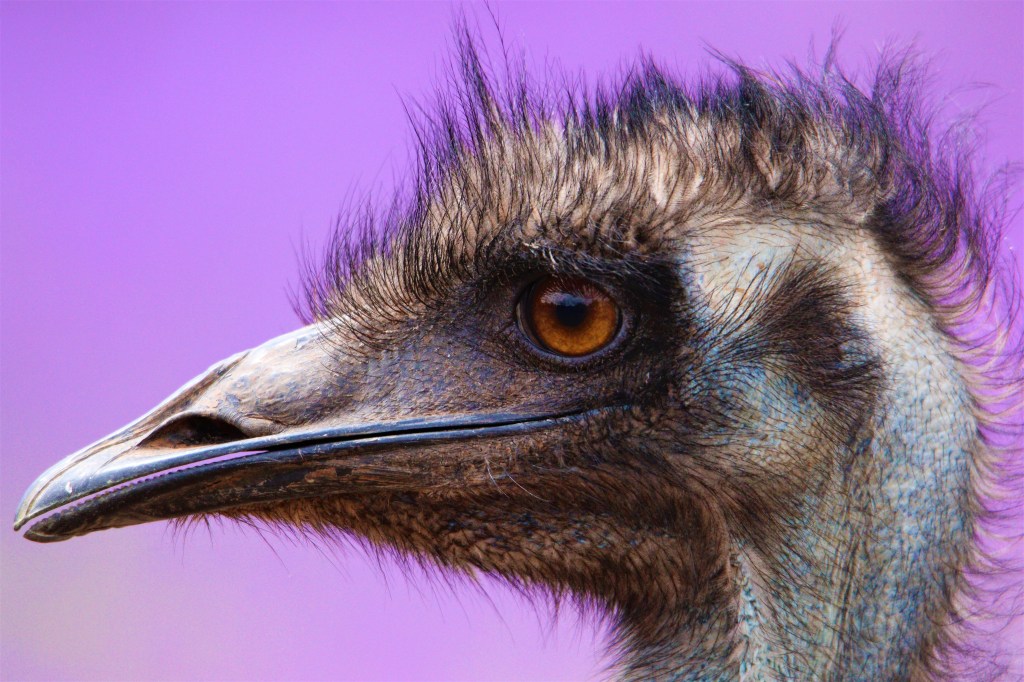
The final day involved relocation to the Arden Vale Range in the Southern Ikara-Flinders en-route to Kangaroo Island. It was a sunny day and I delighted in finding a large docile Bearded Dragon and Sleepy Lizard basking roadside South of Hawker.
Bearded Dragon.

Warren Gorge
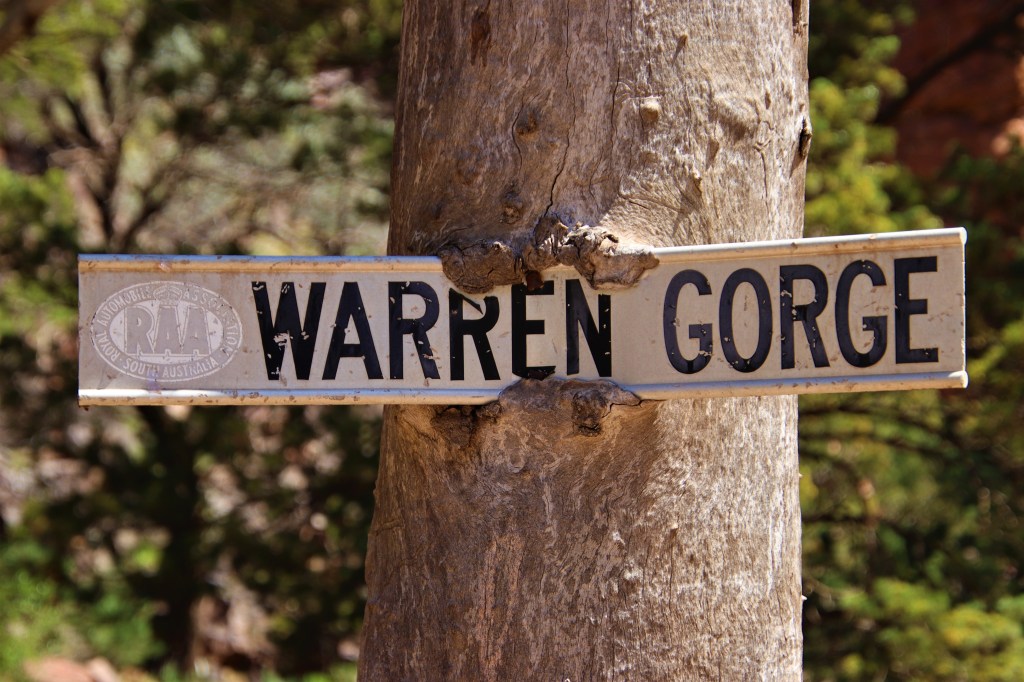
Warren Gorge (along with Telowie Gorge further South) is the most accessible place to see Andu in South Australia. It is located 21km from Quorn along the sealed Arden Vale Road. Day entry to the gorge is $5 per vehicle while overnight camping is $17 per vehicle per night which can be pre-paid at Quorn Visitor Centre. It was delightfully devoid of campers compared to the busier Wilpena Pound Campground at the time of my visit.
https://www.frc.sa.gov.au/tourism/where-to-stay/bushcamping/warren-gorge
The gorge is small, but what it lacks in size is made up for by the spectacular, orange towering cliffs. A lazy ephemeral creek meanders along the base of the gorge, providing water for Andu. Numerous flat campsites are dotted amongst the native pines that line the gorge floor.
Warren Gorge.

It was a beautiful warm, sunny afternoon as I put up the tent watched by a family of inquisitive Apostlebirds. It would be a few hours before Andu could be expected to appear and so I placed the camp chair in a shady spot at the base of a scree slope, where the vehicle track dog legs right. The hot still afternoon air was heavy with the thrum of insect wings, while birdsong reverberated through the treetops, and in absolutely no time I was fast asleep.
I was woken by the voices of a young family trekking past, and opened one eye to scan the scree slope. Initially there was nothing of note, but then movement gave away an Andu browsing high above. The Andu seemed in no rush to descend and so I took a walk down the gorge to stretch my legs, finding a Sleepy Lizard.
I returned to the camp chair and by 6pm had three Andu on the rocks adjacent to the gorge floor. The white, grey and yellow fur of the Andu camouflage well against the rocks of the Ikara-Flinders, so that when still they are almost invisible given away only by movement.
Andu (Yellow-footed Rock Wallaby.)

On dusk I returned down the gorge to the area where the creek crosses the vehicle track just after the Warren Gorge sign being swallowed by the tree. There a further three Andu had descended a scree slope to the gorge floor. Being right on dusk the Andu were reasonably confiding, allowing close approach.
Andu (Yellow-footed Rock Wallaby.)

On the return walk the campsite a scandalously coloured Red-capped Robin flitted between tree branches in the failing light. I sat quietly and the Robin perched a nearby boulder looking for an insect supper.
Red-capped Robin.

As I climbed into the tent the gorge was bathed in bright moonlight and there wasn’t a breath of wind. Warren Gorge is a tranquil place and it was a wonderful place to fall asleep. Despite the damp weather in the Ikara-Flinders it had been wonderful to revisit this very special part of the world.
The following morning I had an early start to drive the six hours to the next part of the trip on Kangaroo Island.
Continued in South Australia Part 3 of 4 – Kangaroo Island
#QuollingAround
All your photos are great but I loved the emu taking a bath! Probably the first time I’ve ever seen a wet emu! Lol. Such beautiful landscapes over there in SA!
LikeLike
Hey Anna, thanks for your kind words. Yeah the emu was having a whale of a time and didn’t worry his bath was in the middle of the road!
LikeLiked by 1 person
Enjoyable read thanks Jimmy and funny at times: Fawlty towers and flailing arms like windmills to escape the storm!
LikeLike
Thanks Tamara!
LikeLike
Brilliant post Jimmy. I agree, the Andu is one of Australia’s most beautiful mammals. We were warned about Arkaroola (humans and the road) and made the decision to drop it on our visit. I’m sorry you had to endure what you did, but you’ve confirmed we made the right decision!
LikeLike
Hey Adam, glad you enjoyed the post. Well done on the Arkaroola call!
LikeLike